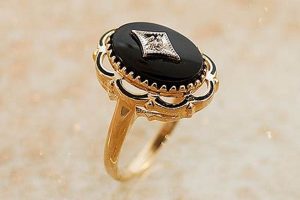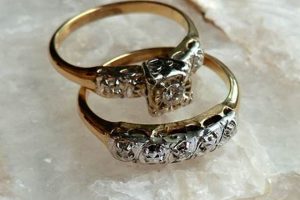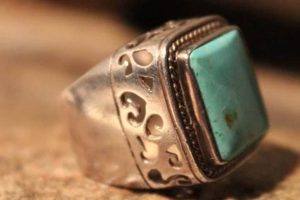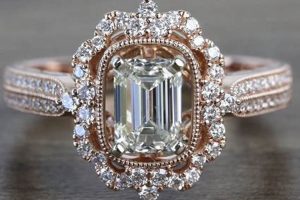Rings designed to evoke the aesthetic of previous eras, such as the Edwardian, Art Deco, or Victorian periods, are increasingly popular. These pieces often feature design elements characteristic of their respective eras, including intricate filigree work, geometric patterns, or unique gemstone cuts. For example, a modern ring might incorporate milgrain detailing along the band, a feature frequently found in antique jewelry, to achieve an older appearance.
The appeal of these rings stems from several factors. The perceived craftsmanship and artistry associated with past eras lends a sense of uniqueness and individuality, differentiating them from mass-produced contemporary designs. Furthermore, individuals are drawn to the perceived romance and historical significance embodied in these styles. The use of ethically sourced materials in crafting these rings can further enhance their value and desirability.
The following sections will delve into specific eras that inspire the design of these sought-after pieces, examining their defining characteristics and gemstone preferences. Furthermore, the article will offer guidance on selecting a piece that reflects individual style and budget, while considering factors such as metal type, stone setting, and overall design integrity.
Guidance on Acquiring a Ring with Period-Inspired Design
The acquisition of a ring emulating designs from bygone eras necessitates careful consideration. Informed decisions based on historical awareness and meticulous examination are paramount to ensure satisfaction.
Tip 1: Research Historical Periods. Understand the distinctive design elements of various eras, such as the Edwardian, Art Deco, and Victorian periods. Familiarity with these styles will aid in discerning authentic details and identifying preferred aesthetics.
Tip 2: Examine Metal Composition. Investigate the metal used in the ring’s construction. Platinum and white gold were common in the early 20th century, while yellow gold was prevalent in earlier periods. Ensure the metal alloy is appropriate for the desired aesthetic and lifestyle.
Tip 3: Inspect Stone Settings. Pay close attention to the setting style. Common historical settings include bezel, prong, and milgrain settings. Evaluate the setting’s integrity and its compatibility with the gemstone.
Tip 4: Evaluate Gemstone Cuts. Gemstone cuts evolved over time. Old European cuts, Asscher cuts, and rose cuts are indicative of particular periods. Consider the cut’s brilliance and its historical accuracy when assessing the ring.
Tip 5: Assess Craftsmanship. Examine the ring for signs of quality craftsmanship. Intricate filigree, hand-engraving, and precise stone setting are hallmarks of well-made pieces. Scrutinize these details for flaws or inconsistencies.
Tip 6: Verify Stone Authenticity. Ensure any gemstones used in ring are assessed by Gemological Institute of America (GIA), International Gemological Institute (IGI), European Gemological Laboratory (EGL) .
Adherence to these guidelines facilitates a more discerning and informed selection process, minimizing the risk of acquiring a piece that fails to meet expectations or historical accuracy standards.
The subsequent sections of this article will provide additional insights into specific design elements and considerations for maintaining the long-term value and beauty of these unique pieces.
1. Intricate Metalwork
Intricate metalwork is a defining characteristic in engagement rings that emulate the aesthetic of past eras. It contributes significantly to the ring’s vintage appearance and perceived artistry, often distinguishing it from more contemporary designs.
- Filigree Embellishment
Filigree involves delicate, thread-like metalwork, typically crafted from gold or platinum. It is characterized by intricate patterns and openwork designs, often incorporated into the ring’s setting or band. An engagement ring featuring elaborate filigree evokes the romantic and ornate styles of the Edwardian era. The complexity and precision of filigree work enhance the ring’s visual appeal and perceived value. Such ornamentation is less commonly found in modern, minimalist ring designs.
- Hand-Engraved Details
Hand-engraving involves using specialized tools to carve intricate designs directly into the metal surface. These designs may include floral motifs, geometric patterns, or personalized inscriptions. An engagement ring featuring hand-engraved details reflects the meticulous craftsmanship associated with vintage jewelry. The presence of hand-engraving signifies a higher level of skill and artistry, differentiating it from machine-engraved alternatives. Its permanence and personalized nature contribute to the ring’s sentimental value.
- Milgrain Edging
Milgrain, also known as “milled grain,” refers to a decorative edging consisting of tiny beads or ridges along the metal’s edge. This detail is frequently found on vintage-inspired engagement rings, particularly those emulating Edwardian or Art Deco styles. Milgrain edging adds a subtle texture and visual interest, enhancing the ring’s overall vintage aesthetic. It can be applied to bezels, shanks, or other prominent areas of the ring’s design. This feature underscores attention to detail and the pursuit of historical accuracy.
- Openwork Designs
Openwork designs involve creating negative space within the metal structure of the ring, allowing light to pass through and highlighting the gemstone. This technique was prevalent in Art Deco jewelry and can be incorporated into modern rings seeking a vintage appearance. Openwork designs add visual complexity and a sense of lightness to the ring. They may feature geometric patterns, floral motifs, or other decorative elements. The interplay of light and shadow created by openwork designs enhances the gemstone’s brilliance and contributes to the ring’s overall aesthetic appeal.
These facets of intricate metalwork collectively contribute to the distinctive appearance of engagement rings designed with a vintage aesthetic. Each element serves to evoke the craftsmanship, artistry, and historical context associated with past eras, rendering these rings a desirable alternative to contemporary styles.
2. Geometric Symmetry
Geometric symmetry is a hallmark of certain historical periods, most notably the Art Deco era, and its presence in modern engagement ring design serves to evoke a distinct vintage aesthetic. This design principle dictates a balanced and proportional arrangement of shapes and patterns, contributing to a sense of order and visual harmony.
- Linearity and Angularity
The Art Deco style favors strong, straight lines and precise angles, often in contrast to the flowing curves of the preceding Art Nouveau period. Engagement rings incorporating this aesthetic may feature baguette-cut diamonds set in stepped patterns or channel settings, emphasizing clean lines and geometric precision. An example is a ring featuring an emerald-cut center stone flanked by trapezoid-cut side stones, creating a balanced and symmetrical arrangement. These sharp, defined shapes are integral to the Deco sensibility.
- Symmetrical Stone Placement
Balanced placement of gemstones is crucial in achieving geometric symmetry. Rings often showcase a central stone flanked by identical side stones or incorporate stones of varying sizes arranged in a mirror-image fashion. For instance, a ring might feature a round brilliant-cut diamond at its center, with smaller round diamonds set symmetrically on either side. The careful arrangement of stones ensures visual equilibrium and reinforces the ring’s symmetrical composition.
- Repetitive Patterns
Repetitive geometric patterns can be employed to enhance the symmetrical design. This might involve repeating a specific shape or motif along the band or within the ring’s setting. An example could be a ring band adorned with repeating chevron or zigzag patterns, creating a visually dynamic and symmetrical effect. The repetition of these patterns reinforces the overall geometric theme and contributes to the ring’s vintage character.
- Architectural Influence
Art Deco design was heavily influenced by architectural styles, particularly those found in skyscrapers and other urban structures. This influence is evident in the stepped designs and layered elements often found in Art Deco engagement rings. A ring might incorporate a stepped bezel setting or a tiered design reminiscent of a skyscraper’s silhouette, reflecting the era’s fascination with modernity and industrial progress. These architectural elements enhance the ring’s geometric complexity and contribute to its distinctive appearance.
In summary, the presence of geometric symmetry, manifested through linearity, balanced stone placement, repetitive patterns, and architectural influences, significantly contributes to the perception of an engagement ring as having a vintage look, particularly one reminiscent of the Art Deco period. These elements coalesce to create a visually striking and historically evocative design.
3. Filigree Detailing
Filigree detailing directly contributes to the perception of an engagement ring as possessing a vintage aesthetic. The intricate, lace-like metalwork characteristic of filigree evokes design sensibilities prevalent in the Edwardian and Art Deco eras, thereby establishing a visual connection to these historical periods. The presence of filigree is often a deliberate design choice intended to imbue the ring with a sense of age and handcrafted artistry, differentiating it from the smoother, more streamlined designs of contemporary jewelry. For example, a ring featuring a platinum setting with delicate wirework surrounding a center diamond immediately suggests a design influence predating modern manufacturing techniques.
The significance of filigree extends beyond mere aesthetics; it represents a commitment to craftsmanship and attention to detail. Creating filigree requires skilled artisans who meticulously shape and solder fine metal threads to form intricate patterns. This labor-intensive process contrasts sharply with the mass-produced nature of much contemporary jewelry. Furthermore, the presence of filigree can enhance the perceived value of an engagement ring, signaling a higher level of quality and design. Practical application of this understanding allows consumers to discern authentic vintage-inspired designs from those merely imitating the style. Identifying genuine filigree work, characterized by clean lines and precise execution, indicates a higher level of craftsmanship.
In summary, filigree detailing serves as a key element in achieving a “vintage looking engagement ring” aesthetic. Its visual impact, coupled with its representation of skilled craftsmanship, contributes significantly to the ring’s perceived value and historical character. However, appreciating the nuances of filigree design also necessitates an awareness of potential challenges, such as the fragility of delicate metalwork and the need for careful maintenance to preserve its integrity. By understanding the connection between filigree and vintage aesthetics, individuals can make more informed decisions when selecting an engagement ring that reflects their personal style and appreciation for historical design.
4. Milgrain Edges
Milgrain edging, also known as “milled grain,” is a subtle yet significant design element employed to imbue jewelry, particularly rings, with an aesthetic evocative of earlier periods. Its application transforms contemporary pieces into approximations of antique craftsmanship, thereby contributing substantially to the perception of a “vintage looking engagement ring.”
- Definition and Application
Milgrain refers to the small, bead-like details applied to the edges or surfaces of metalwork. These beads are typically created using specialized tools that precisely imprint the metal, resulting in a textured border. On engagement rings, milgrain is commonly applied to the edges of bezels, shanks, or any area where a defined border is desired. Its presence mimics the hand-worked details found in rings from the Edwardian, Art Deco, and Victorian eras, where such fine detailing was a hallmark of quality craftsmanship.
- Historical Significance
The prevalence of milgrain in vintage jewelry underscores its historical significance. In eras preceding modern mass-production techniques, jewelers often employed milgrain as a means of adding visual interest and a touch of luxury to their creations. This design element served to highlight the skill and artistry of the craftsman. Consequently, modern rings incorporating milgrain aim to capture this sense of historical authenticity and artisanal quality.
- Visual Impact and Aesthetic Contribution
The visual impact of milgrain, while subtle, is critical to achieving a vintage look. The textured edge created by milgrain adds depth and complexity to the ring’s design. This detail contrasts with the smooth, unadorned surfaces often found in contemporary rings, creating a visual cue that signals a connection to the past. Moreover, milgrain enhances the play of light on the metal surface, further contributing to the ring’s overall visual appeal and perceived age.
- Maintenance Considerations
While milgrain adds aesthetic value, it also necessitates careful maintenance. Due to its intricate nature, milgrain can accumulate dirt and debris, diminishing its visual impact. Regular cleaning with a soft brush and mild soap is essential to preserve its appearance. Furthermore, the delicate nature of milgrain makes it susceptible to wear and damage. Over time, the beads can flatten or wear away, requiring periodic restoration by a skilled jeweler. Acknowledging these maintenance considerations is crucial for individuals seeking to maintain the long-term beauty of a ring featuring milgrain edges.
In conclusion, milgrain edges represent a deliberate design choice intended to evoke the craftsmanship and aesthetic sensibilities of past eras. Its application enhances the visual complexity and perceived value of engagement rings, contributing significantly to their vintage character. However, appreciating the nuances of milgrain also necessitates an understanding of its maintenance requirements, ensuring that its beauty endures over time.
5. Unique Stone Cuts
The selection of unconventional gemstone shapes is instrumental in establishing the vintage aesthetic of an engagement ring. These cuts, deviating from contemporary standards, serve as visual cues that immediately communicate a connection to past eras. Therefore, a comprehensive understanding of these unique stone cuts is essential when evaluating designs for a period-inspired ring.
- Old European Cut
The Old European Cut, prevalent from the late 19th century to the early 20th century, exhibits a round shape but features a smaller table, higher crown, and larger culet compared to modern round brilliant cuts. These proportions result in a distinct light performance, characterized by a warmer, less fiery brilliance. The presence of an Old European Cut diamond in an engagement ring is a strong indicator of vintage inspiration, immediately setting it apart from rings featuring modern cuts. The unique facet pattern and light dispersion of this cut are significant factors in achieving a vintage aesthetic.
- Asscher Cut
The Asscher Cut, developed in 1902, is a step-cut square diamond characterized by its cropped corners, large step facets, and high crown. This cut produces a distinctive “hall of mirrors” effect, with light reflecting off the step facets in a concentric pattern. The Asscher Cut is strongly associated with the Art Deco era and is a highly effective choice for engagement rings seeking to capture this period’s aesthetic. Its geometric shape and sophisticated light performance contribute significantly to the ring’s vintage appearance, offering a refined alternative to more common diamond shapes.
- Rose Cut
The Rose Cut, popular in the 16th and 17th centuries, features a flat base and a domed top comprised of triangular facets arranged in a rose-like pattern. This cut has fewer facets than modern cuts, resulting in a softer, more subtle brilliance. The Rose Cut imparts a romantic and antique feel to an engagement ring, harkening back to a time when diamonds were valued more for their clarity and shape than for their intense sparkle. Its unique faceting and delicate appearance make it a distinctive choice for those seeking a truly vintage-inspired design.
- Marquise Cut
While the marquise cut is still used today, it was more popular in vintage designs and it can contribute to a vintage aesthetic, especially when combined with other vintage elements. The marquise cut is a modified brilliant cut with an elongated shape that is pointed at both ends. When set East-West (horizontally) it is can further contribute to a unique vintage feel.
In conclusion, the strategic use of unique stone cuts, such as the Old European, Asscher, and Rose cuts, is a decisive factor in creating an engagement ring with a vintage aesthetic. These cuts, each possessing distinct characteristics and historical associations, serve to differentiate these rings from contemporary designs, imbuing them with a sense of history and handcrafted artistry.
Frequently Asked Questions
The following section addresses common inquiries regarding engagement rings designed to emulate historical styles. These questions aim to clarify key aspects and considerations when evaluating such pieces.
Question 1: What distinguishes a ‘vintage looking engagement ring’ from a genuine antique?
A ‘vintage looking engagement ring’ is a newly manufactured piece designed to resemble styles from previous eras, while a genuine antique ring is an original piece from that period. The former uses modern manufacturing techniques and materials, while the latter possesses historical provenance.
Question 2: Which historical periods most commonly inspire ‘vintage looking engagement ring’ designs?
The Edwardian, Art Deco, and Victorian eras are the most frequent sources of inspiration. Each era is characterized by distinct design elements, such as intricate filigree (Edwardian), geometric patterns (Art Deco), and ornate floral motifs (Victorian).
Question 3: What are the primary gemstone cuts associated with ‘vintage looking engagement rings’?
Old European cuts, Asscher cuts, and Rose cuts are commonly employed to replicate historical aesthetics. These cuts differ from modern brilliant cuts in their facet patterns and light performance, contributing to a vintage appearance.
Question 4: What materials are typically used in the construction of ‘vintage looking engagement rings’?
Platinum and white gold are frequently used to emulate the aesthetics of the early 20th century. Yellow gold is also common, reflecting styles from earlier periods. The choice of metal impacts the ring’s overall appearance and durability.
Question 5: How does one assess the quality of a ‘vintage looking engagement ring’?
Quality assessment involves examining the craftsmanship, including the precision of metalwork, the integrity of stone settings, and the overall design execution. High-quality pieces exhibit meticulous attention to detail and durable construction.
Question 6: What are the key maintenance considerations for a ‘vintage looking engagement ring’?
Due to intricate details like filigree and milgrain, regular cleaning with a soft brush and mild soap is essential. The ring should also be inspected periodically by a jeweler to address any potential damage or wear.
In summary, understanding the distinctions between reproduction and antique pieces, recognizing key design elements from different eras, and considering materials and maintenance requirements are crucial when acquiring a ‘vintage looking engagement ring’.
The subsequent section will provide guidance on selecting a reputable jeweler specializing in vintage-inspired designs.
Conclusion
This exploration of the “vintage looking engagement ring” has illuminated the key elements that contribute to its distinctive aesthetic. From intricate metalwork and geometric symmetry to filigree detailing, milgrain edges, and unique stone cuts, these design choices evoke the craftsmanship and styles of bygone eras. The deliberate selection and execution of these elements differentiate such rings from contemporary designs, offering a connection to history and a sense of timeless elegance.
The enduring appeal of the “vintage looking engagement ring” underscores a continued appreciation for artistry and detailed craftsmanship. Prospective purchasers are encouraged to carefully consider the factors outlined, ensuring that their selection reflects both personal style and an informed understanding of historical design principles. This informed approach guarantees the value of such rings.







